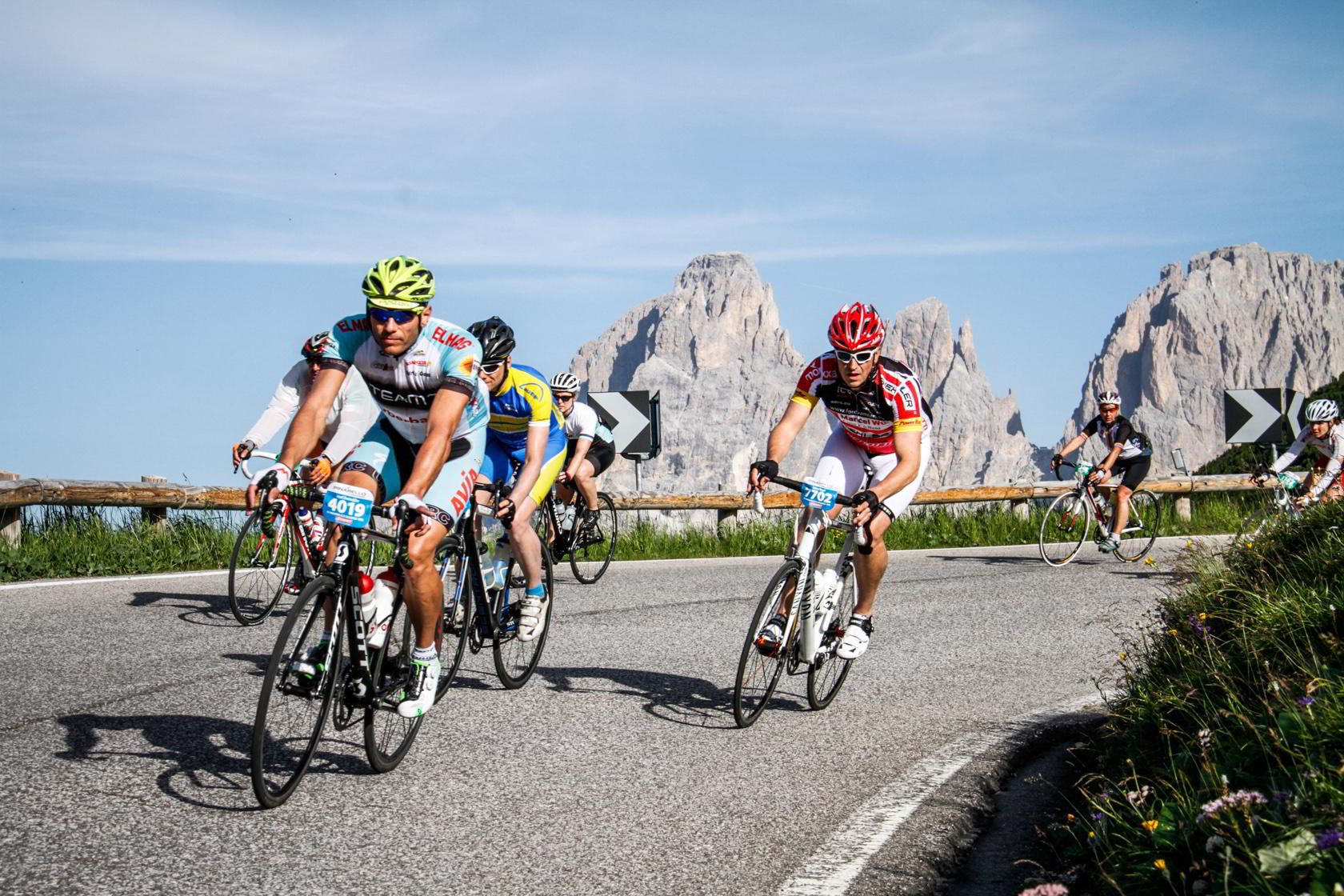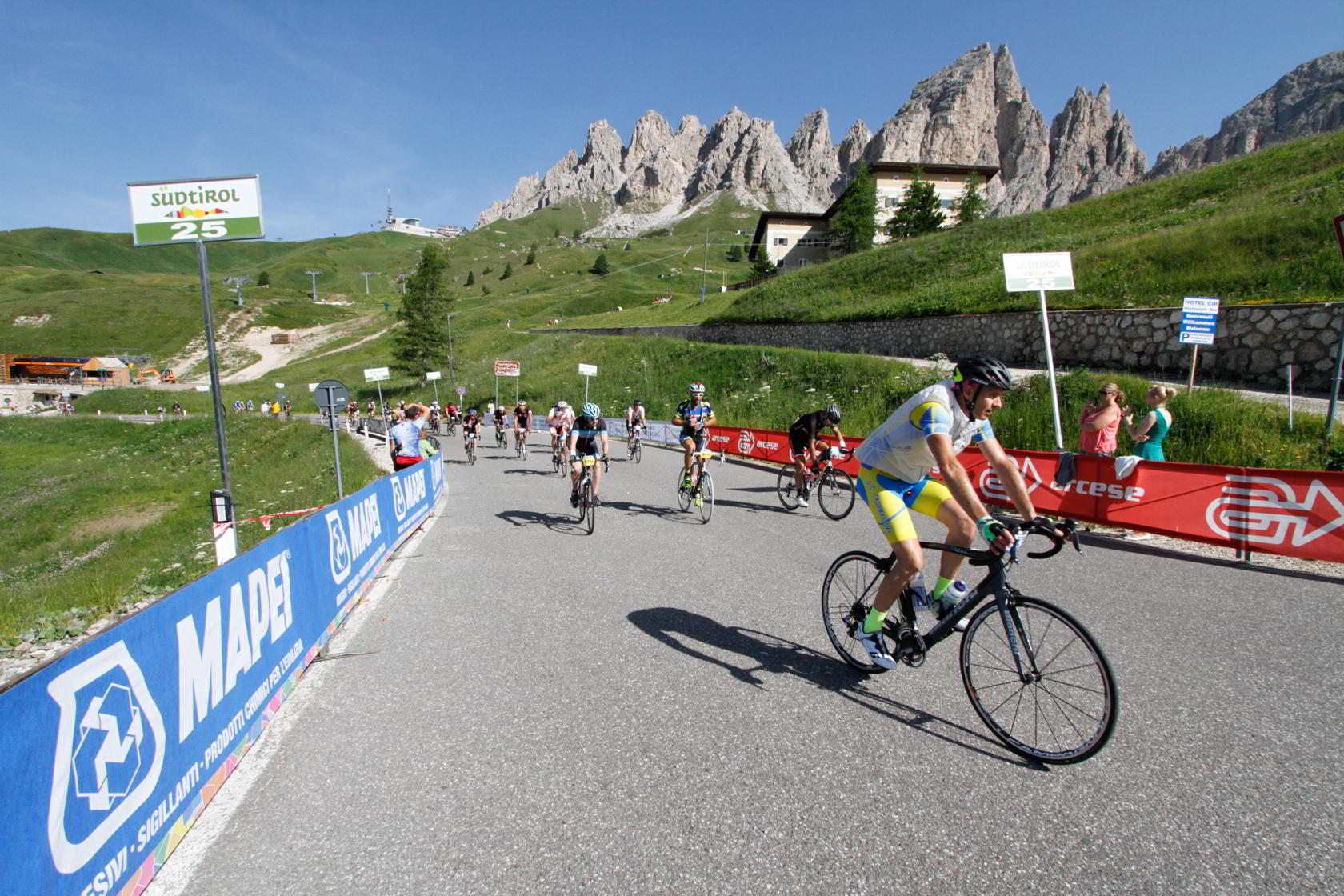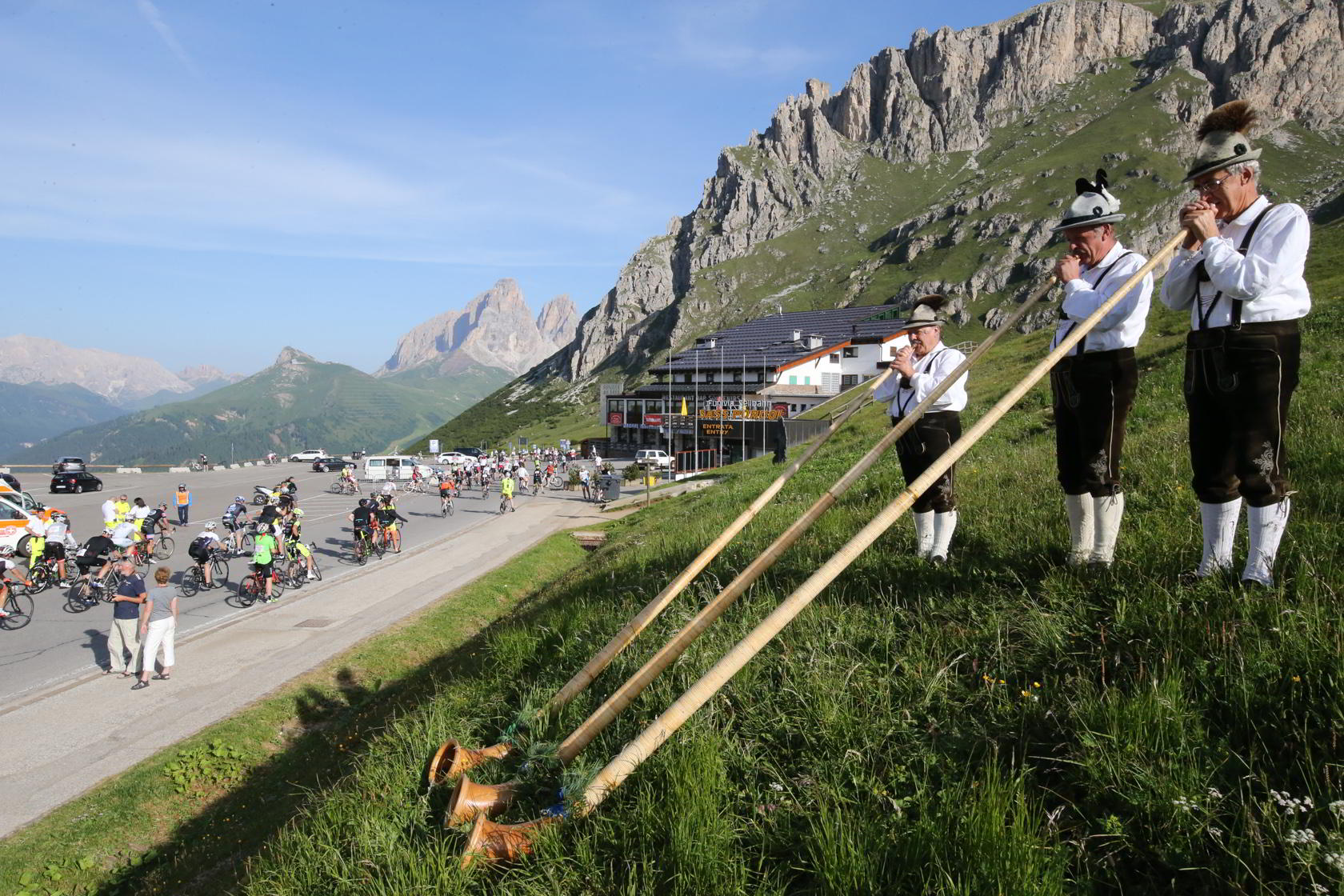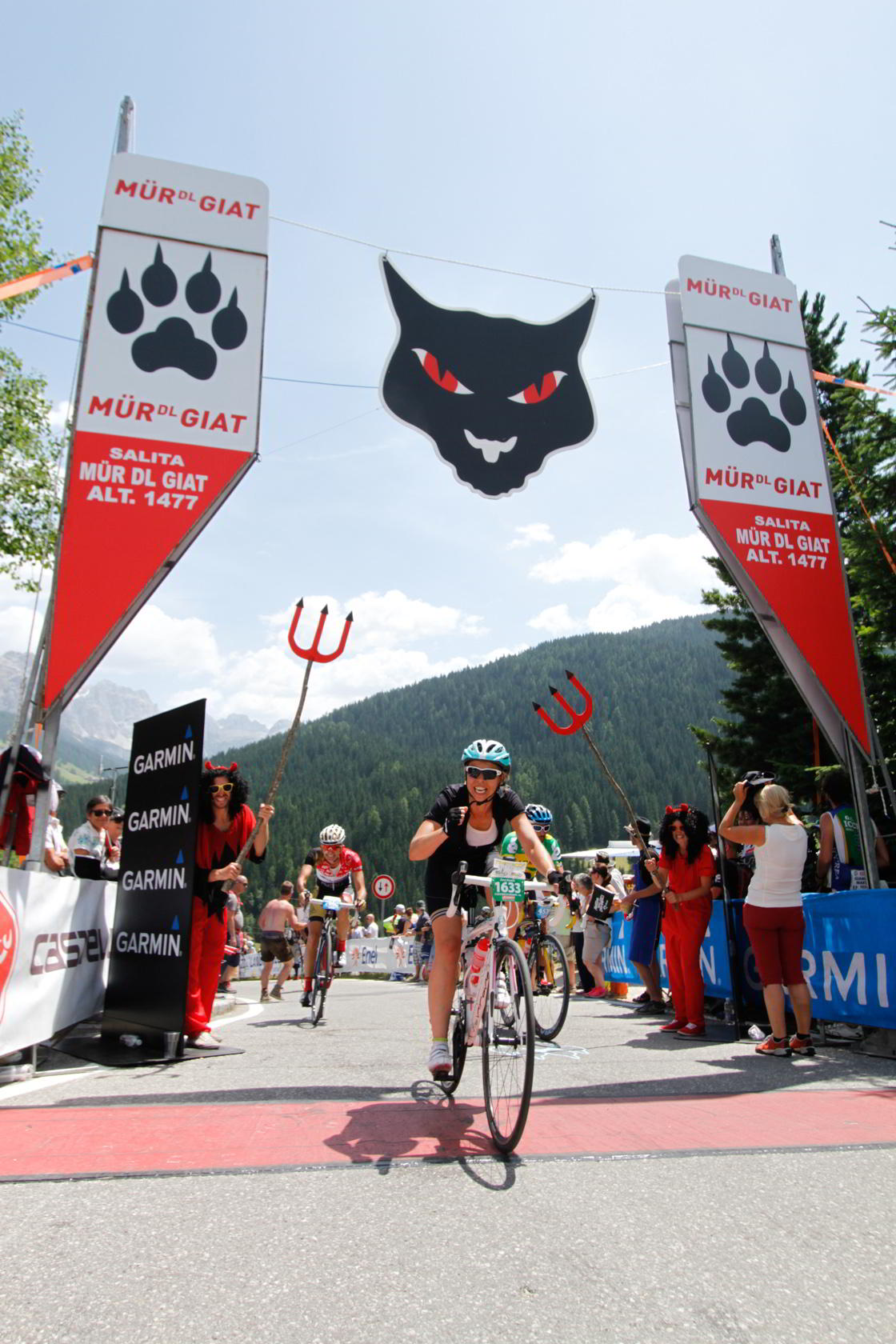Riding the Maratona dles Dolomites
The gran fondo is set to test riders’ legs on classic Italian passes for the 30th time


A shot went off from a helicopter hovering above 9,000 cyclists. It was the type of explosion used to trigger avalanches in the Dolomite mountains in Italy’s northeast. The riders then began to slide out from their staging corrals. Right at the start line, a brass band began playing Ozzy Osbourne’s “Crazy Train.” It was 6:30 a.m. Fifteen minutes before, a live broadcast of the event had started on Rai 3, Italian public television, and would continue for roughly six hours, although many cyclists would be on their bikes for eight to nine hours, just as food, medical and mechanical support would begin to close up. But just after dawn, the Maratona dles Dolomites–Enel, a gran fondo that wraps a cycling carnival around a test of endurance, just got started.
RELATED Pantani’s playground: Riding in Italy’s Emilia-Romagna region
I had a ridiculously low bib number, 146, which put me in the first wave. As we rode the first 4 km from La Villa to Corvara, we filled the width of the closed road. Many riders were hammering to get by the mass of people and bikes. There was a crash, which I thought was just dumb. There’s no cash for finishing first. Pros are not supposed to participate, but if they get special permission, their times aren’t recorded. Why risk a fall? In Corvara, the inclines of Passo Campolongo really showed themselves. The road was still full, but calmer as everyone settled in for the 6 km that averaged 6.1 per cent. Later, we’d get to see Campolongo a second time.

The first Maratona featured 166 riders who rode 175 km over seven passes on July 12, 1987. The route changed a bit each year as the list of participants grew steadily. In 2006, the current 138-km course was set. It goes over passes Campolongo, Pordoi, Sella, Gardena, Campolongo once again, then Giau and Valparola via Falzarego. The elevation gain is 4,230 m, definitely a course for mountain goats. On May 21, to honour the Maratona’s 30th edition in July, Stage 14 of the Giro d’Italia will start in Alpago and head north so the pros can cover the full route of the gran fondo. Passo Pordoi has featured in the Italian Grand Tour more than the other climbs. In 2012, Ryder Hesjedal finished third on Stage 17 and remained in second overall behind stage winner and then pink-jersey wearer Joaquim Rodriguez. Still, it was Hesjedal’s performance on Giau, unwavering, that had the other top contenders figuring the Canadian could win the Giro, which he did with the final time trial in Milan.
This past July, I rode in the 29th edition of the Maratona thanks to Castelli. The Italian high-end cycling clothing maker ran a contest with this magazine. Jordan Behan of Vancouver won and his prize was a flight to Italy, accommodation and entry into the fondo. I joined him for the ride and to test some Castelli kit. The company, based in Fonzaso about 100 km to the south, had become the event’s clothing sponsor that year and will be back for another three years.

I had started the day with arm warmers and a vest, but was pulling them off on the first climb. It was hot. Later, I couldn’t understand why most of the European riders put their gilets back on at the top of each climb. The cooling breeze on the long descents that followed was a relief to me. My bike was a Cervélo R3 from Castelli’s fleet. It was a great machine for the task at hand with its Shimano Di2 setup. Now, I’ll never complain about a bike that someone else was kind enough to arrange for me, but if I were to do the Maratona again, I’d avoid another 11-23 cassette. You want your granny gear to be at least a 25-tooth, although, I think a 28-tooth would be ideal.
A few days before the big ride, Jordan, riders from Castelli and a few of their friends and I rode the Sella Ronda loop, which covers the first four climbs. It’s also the shortest option, 55 km, for those who don’t want to ride the full 138 km or the 106-km medio route. My favourite climb of the short loop is Passo Sella. On Sella, you are in the forest, as opposed to the fields that line Campolongo and Pordoi. The mountains even seem closer on Sella. Near the top, you can see the glacier on Marmolada, the highest peak in the Dolomites.

On the day of the fondo, not long into the climb up Sella, I heard this din coming from up the road. It sounded mechanical and medieval, and it kept getting louder. I finally saw about 15 people lining the road waving what looked like cauldrons of various sizes. There were wooden-box noisemakers, too. One seemed to have a spiky cylinder that was spun around like some rustic organ grinder. I later learned that I rode through a jam session of folk instruments that come from the nearby Val di Fassa. Fassa and four neighbouring valleys are home to the Ladin people, a minority with its own language also called Ladin. The Ladin instruments beat any cowbell encouragement I’ve ever received.
After the cacophony gauntlet, it was up and over Sella, then Gardena, Campolongo again, and then down, mostly down, to the base of Giau. Passo Giau is 10 km and takes you up 922 m. It has 29 switchbacks, but I swear the sign near the start of the pass said 27. Grades get as high as 15 per cent. When they dipped down to six or five per cent, I felt relief. I watched one rider zigzag his way up, using the width of the road to cut down the grade. By the time I got to the top, I felt close to bonking so I took it easy at the food station. I lost time, but I needed those two ham-and-cheese sandwiches, and pop and energy drink and water.

The final climb up Valparola is the longest at 11.8 km. I wasn’t fresh but I didn’t suffer as much as I did on Giau. My following descent felt like my fastest of the day. Knowing the finish was a mere 15 km away likely gave me some extra zip. At the Mür dl Giat (Ladin for Cat’s Wall), I confess, I got a little argy-bargy. The wall is a 360-m section that hits 19 per cent. At kilometre 101, many riders don’t have it in the legs to get up this little kicker. They either go up as if on a stair machine or simply walk and fill up the road. That wasn’t going to be me. I got a good head of steam, yelled, “Left! Left! Sinistra! Sinistra!” as I aimed for that line. I bumped bars with rider who weaved in front of me, and then kept on going to the top. I admit, it wasn’t gentlemanly at all, but it did the trick.
At the finish in Corvara, hundreds of riders celebrated with pasta and beer. We had all finished a bucket-list ride. It was then time to relax in Italy’s Dolomite mountains.

Details
Entering the Maratona dles Dolomites
While the Maratona is big with 9,000 cyclists riding one of its three routes, it’s also very popular. For the 2016 edition, a record 33,000 applicants entered the draw last fall for 5,000 available spots in the July 3 event. The fee for the draw was €2 (roughly $3) and the entry fee is €110 ($170). On Nov. 24, 193 spots ranging in price from €250 ($385), €500 ($765) and €1,500 ($2,300) became available. All proceeds beyond the €110 base fee go to charity. On March 26, 193 more spots with a charitable component become available. Finally, you can buy a package from select tour operators that includes entry into the event.
Getting there
To get to the Alta Badia region, the area in Italy’s northeast in which the Maratona runs, a flight to Venice is probably your best bet followed by a car rental. Venice is roughly 200 km away. Closer airports in Bolzano (100 km), Treviso (180 km) and Innsbruck (130 km) are also options. You can get to Corvara by train and then bus, but you will spend a lot of time doing so. Besides, driving a motorized vehicle in the Dolomites is almost as fun as cycling.
Where to sleep
The Alta Badia region, which is a prime ski location in the winter, has many accommodation options – everything from five star hotels to camping. Your best resource for places to stay is the tourism website for the region: altabadia.org. Posta Zirm in Corvara is a fantastic hotel that caters to skiers in the winter and easily changes gears for cyclists in the summer. You can leave you bike in a secure room, or just bring it up to your suite. Hotel Greif is another high-end option in Corvara, which is a good town to stay in as the Maratona finishes there. After you cross the line and then finish your pasta, it’s a short pedal back to your room.
Where to eat
The restaurant at Posta Zirm has a great mix of local Ladin cuisine with some modern touches. You definitely see the influence of nearby Austria and Bavaria with Italian classics. In the area, there are also pubs, such as Durni’s in La Villa, and many pizzerias, such as Caterina’s in Corvara. When you pre-ride some of the local passes, you’ll find cafés and bars at the top of most of the climbs. Take in a mid-ride espresso. It’s also a great way to take in the view.
Where to find support
Breakout Sport, with locations in La Villa and Corvara, is just the place for cycling essentials. They will be very busy during the time of the Maratona.

